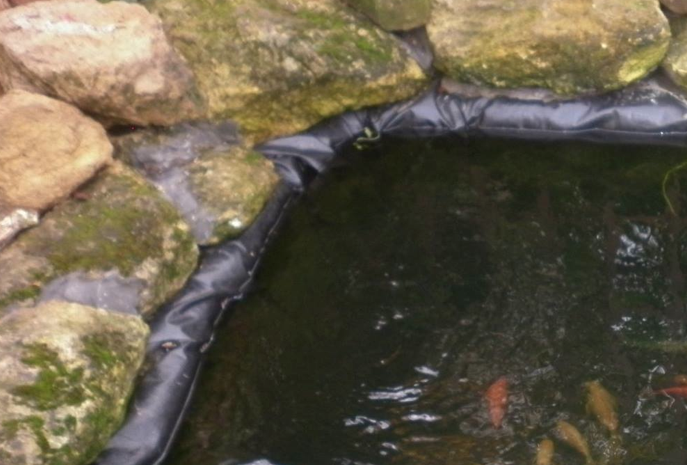Perhaps you are wondering why I am writing about ponds and pond construction in the winter. Well, because it is a perfect time to get all the planning, preparation and excavation complete in the winter so that you can focus on planting and nurturing during the spring and summer months. Plus, to allow you time to sit back and reap the rewards of your amazing creation when the weather is warmer. In this article we look at the edging for a pond and why you should consider adding a trench around your pond to maintain healthy water quality.
The four basic steps to building a pond are: dig the hole, install the protective underlay liner and then your choice of pond liner, fill pond with water and secure your pond liner in place with your choice of edging material.
During the digging stage of your pond build you should include a 15cm deep trench around the outside of your pond. This will create a barrier preventing rainwater run off entering your pond and polluting it with products used on your garden such as fertilisers and pesticides. The trench needs to be about 15cm wide x 15cm deep around the outer edge of the pond approximately 25cm from the pond’s edge. This trench can then be filled with pebbles, which will allow the garden run off water to by pass your pond and continue on its natural path.
When installing the protective underlay and pond liner take them to just beyond the trench and push them (first the underlay and then the pond liner) into the contours of the hole folding the corners as neatly as possible and smoothing out as many wrinkles as possible while slowly adding the water. As the water weighs down on the liners, keep smoothing out any folds and wrinkles to give your pond the perfect finish. Once filled, wait about two ponds the pond to ‘settle’ down and then you can start working on adding the edging material to secure your pond liner in place and to protect it from possible damage by sunlight and visiting wildlife. Trim off any excess pond liner and underlay that goes beyond the edge of the trench. Push the liners into the trench and secure them in place with lots of small, smooth pebbles. If you plan to place any large rocks within the pond you can use the off cuts of liner to provide extra protection against possible damage by the weight of the rock.
You are now ready to add the edging material of your choice around the pond perimeter. Objects commonly used include railway sleepers, paving blocks, pebbles or natural stone. The choice is often chosen according to the type of pond i.e a natural look created by pebbles or turf for wildlife ponds versus brick or natural stone for a formal, regular shaped pond.
Taking the edging material just over the lip of the pond will offer added protection to the pond liner. If you are creating a wildlife pond, you should provide them sufficient access into and out of the water.  This can be achieved by creating a beach effect by adding a pebbled surface area to one side of your pond. Whatever edging type you decide, make sure it is secured in place so that anyone standing on it won’t loosen its grip and end-up in the water.
This can be achieved by creating a beach effect by adding a pebbled surface area to one side of your pond. Whatever edging type you decide, make sure it is secured in place so that anyone standing on it won’t loosen its grip and end-up in the water.
>
How to hide your pond liner under the edging
A natural pond can be created by adding a border of rocks and boulders around the edges as shown in the photograph. However, it would have been better if the boulders had been allowed to overhang the water by one or two inches. To prevent the pond liner from showing, the water needs to meet the rock edging. During the digging phase, a shallow shelf should be dug-out around the periphery of the pond as an area for placing the rock edging. When the pond is filled, the rocks around the edge of the pond will be partially covered by water, hiding the pond liner.
If not planned and executed correctly, poor edging may leave your pond liner exposed (some types of pond liners such as Butyl and Epalyn rubber pond liners are resistant to UV rays however, their exposure could mean vulnerability to the claws of visiting wildlife. For pond liners such as a PVC liner exposure to the sun will shorten its life expectancy) and it can spoil the success and physical beauty of your pond.






I see interesting posts here. Your blog can go viral easily, you need some initial
traffic only. You should read about bucksflooder , this might interest
you.
I have been surfing online more than three hours today, yet I never found any interesting article like yours. It is pretty worth enough for me. In my opinion, if all web owners and bloggers made good content as you did, the net will be a lot more useful than ever before.
Great looking internet site. Presume you did a bunch of your ownyour very own html coding
Eidur Gudjohnsen http://www.szcaf.com/home.php?mod=space&uid=137879&do=profile
Great looking site. Presume you did a great deal of your ownyour very own html coding
Julio Cruz http://www.boxesnet.com/content/assassins-creed-4-world-premeire-trailer-dev-says-black-flag-has-new-feel
Thanks for the purpose of offering these sort of terrific subject matter
Caniggia http://n021.cn/comment/html/?51257.html